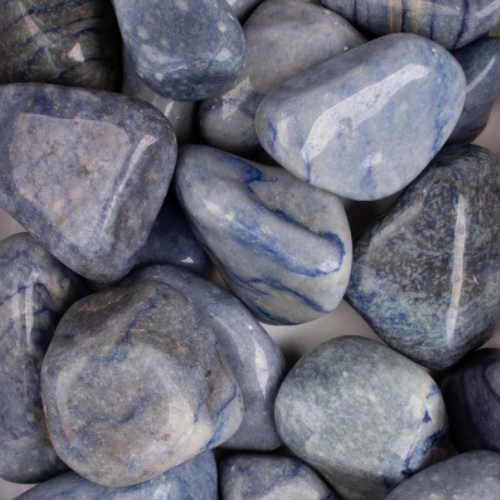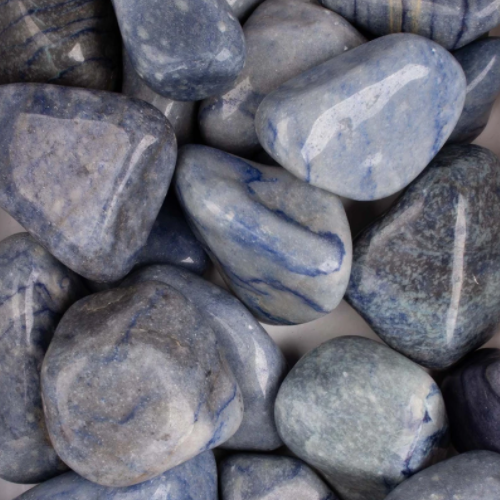Product Description
Quartz Blue Tumbled Stone >2"
Less than 10 ounces.
Mineral Information:
Blue quartz is a variety of quartz that exhibits a blue color due to the presence of trace elements or inclusions within the crystal structure. It can occur in different shades of blue, ranging from pale and translucent to deep and vibrant. Here are some key features and characteristics of blue quartz:
Color: Blue quartz displays a range of blue hues, including light baby blue, sky blue, and darker shades such as navy or royal blue. The intensity and saturation of the color can vary, giving each specimen its unique appearance.
Transparency: Blue quartz can be either transparent or translucent, depending on the specific specimen. Some pieces may have a high level of transparency, allowing light to pass through, while others may have a cloudy or milky appearance due to inclusions or impurities.
Hardness: Blue quartz has a hardness of 7 on the Mohs scale, which indicates good durability and resistance to scratches. It is relatively tough and can withstand everyday wear and handling, making it suitable for jewelry use.
Origin: Blue quartz is found in various locations around the world, including Brazil, Madagascar, India, and the United States. Each location may produce variations in color, clarity, and quality.
Metaphysical Meaning:
Blue quartz is used for its calming and soothing energy that helps with decreasing anxiety and creating a more relaxed mind. It is used for communication and especially communication that involves emotions. Blue quartz can help to stimulate the throat chakra, which is associated with communication and expression. It is also good for promoting traquility and serenity.
Blue quartz is a powerful crystal that increases inner peace and is often used in meditation and energy healing practices to help promote a deep sense of calm.
Mineral Care:
Blue quartz, like other varieties of quartz, is relatively durable and not particularly fragile. However, it still requires some care to prevent potential damage. Here are some factors to consider regarding the fragility of blue quartz:
-
Hardness: Blue quartz has a hardness of 7 on the Mohs scale, which indicates good resistance to scratches. It can withstand everyday wear and handling without easily getting scratched by most objects. However, it is still possible to scratch blue quartz with harder materials or objects with a higher Mohs hardness. It is advisable to store blue quartz separately from other gemstones or objects that could potentially scratch it.
-
Cleavage: Blue quartz, like other quartz varieties, does not have distinct cleavage planes. This means it does not easily break along specific planes or directions. Instead, it exhibits a conchoidal fracture, breaking with curved, shell-like surfaces. This fracture pattern can make blue quartz less prone to cleavage-related fragility. However, care should still be taken to avoid subjecting it to forceful impacts or pressure that could cause it to chip or fracture.
-
Heat Sensitivity: Blue quartz is generally heat resistant and can withstand normal temperature changes. However, extreme temperature fluctuations can potentially pose a risk to the gemstone, especially if it contains internal flaws or fractures. Rapid or drastic temperature changes can create stress within the crystal structure, leading to cracks or breakage. It is advisable to avoid exposing blue quartz to sudden temperature changes, such as immersing it in hot water and then placing it in cold water.
-
Chemical Sensitivity: Blue quartz is generally resistant to most household chemicals and cleaning agents. However, it is still recommended to avoid exposing it to harsh chemicals or strong acids that could potentially damage or corrode the stone. Clean blue quartz using mild soapy water and a soft cloth, and avoid using abrasive cleaners or chemical solutions.
While blue quartz is not considered highly fragile, it is still important to handle it with care to protect its beauty and integrity. Avoid subjecting it to rough handling, impacts, extreme temperature changes, or exposure to harsh chemicals. By following proper handling and care practices, you can help maintain the quality and longevity of your blue quartz gemstone or jewelry.
Disclaimer:
No information here is intended to diagnose, treat or cure ailments or afflictions of any kind. One should always consult a medical professional if a serious issue presents itself.







